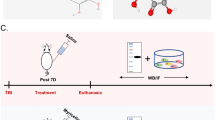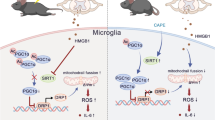Abstract
Spinal cord injury (SCI) is a serious, prolonged, and irreversible injury with few therapeutic options. Albiflorin (AF) possesses powerful pharmacodynamic properties and exerts protective effects against neuroinflammation. However, no research has examined the neuroprotective effect of AF following SCI. Rats were received laminectomy to establish SCI animal model and treated with AF (20 mg/kg and 40 mg/kg). Behavioral experiments were conducted to assess the impacts of AF on motor function after SCI in rats. Hematoxylin–eosin (HE) staining, Nissl staining, and Prussian Blue staining were performed to observe histological changes, neuronal damage, and iron deposition, respectively. Transmission electron microscope was adopted to observe the ultrastructure of spinal cord tissues. Immunofluorescence assay was performed to examine neurons and microglia. ELISA assay was used to examine the production of cytokines. Western blot assay was used to detect the expression level of ferroptosis-related proteins. Microglia BV-2 cells were induced by LPS to mimic the neuroinflammatory condition. Cell viability was assessed by CCK-8 assay, and lipid peroxidase level was measured by C11 BODIPY 581/591 staining. Molecular docking technology was utilized to confirm the relationship between AF and LSD1. AF improved the motor functional recovery after SCI in rats. Meanwhile, AF attenuated neuron apoptosis and microglia activation, reduced the production of pro-inflammatory cytokines and iron accumulation, and inhibited spinal cord ferroptosis following SCI in rats. LSD1 was verified to be a target protein of AF, and AF could concentration-dependently downregulate LSD1 expression in injured spinal cords in vivo and LPS-induced BV-2 cells in vitro. In addition, AF not only inhibited ferroptosis through reducing lipid peroxidase and iron levels and regulating ferroptosis-related proteins, but also inhibited microglial activation and reduced pro-inflammatory cytokines production in LPS-induced BV-2 cells; however, these changes were partly counteracted by LSD1 overexpression. AF could reduce microglial activation and ferroptosis, attenuate neuroinflammation, and improve functional recovery following SCI by downregulating LSD1, providing novel therapeutic strategies for the treatment of SCI.







Similar content being viewed by others
Data Availability
No datasets were generated or analysed during the current study.
References
Collaborators, G.B.D.N. 2019. Global, regional, and national burden of neurological disorders, 1990–2016: A systematic analysis for the Global Burden of Disease Study 2016. Lancet Neurology 18: 459–480.
Ahuja, C.S., S. Nori, L. Tetreault, J. Wilson, B. Kwon, J. Harrop, et al. 2017. Traumatic spinal cord injury-repair and regeneration. Neurosurgery 80: S9–S22.
Khorasanizadeh, M., M. Yousefifard, M. Eskian, Y. Lu, M. Chalangari, J.S. Harrop, et al. 2019. Neurological recovery following traumatic spinal cord injury: A systematic review and meta-analysis. Journal of Neurosurgery: Spine 1–17.
Flack, J.A., K.D. Sharma, and J.Y. Xie. 2022. Delving into the recent advancements of spinal cord injury treatment: A review of recent progress. Neural Regeneration Research 17: 283–291.
Clifford, T., Z. Finkel, B. Rodriguez, A. Joseph, and L. Cai. 2023. Current advancements in spinal cord injury research-glial scar formation and neural regeneration. Cells 12: 853.
David, S., and A. Kroner. 2011. Repertoire of microglial and macrophage responses after spinal cord injury. Nature Reviews Neuroscience 12: 388–399.
Song, J., X. Hou, X. Hu, C. Lu, C. Liu, J. Wang, et al. 2015. Not only serotonergic system, but also dopaminergic system involved in albiflorin against chronic unpredictable mild stress-induced depression-like behavior in rats. Chemico-Biological Interactions 242: 211–217.
Cai, Z., J. Liu, H. Bian, and J. Cai. 2019. Albiflorin alleviates ovalbumin (OVA)-induced pulmonary inflammation in asthmatic mice. American Journal of Translational Research 11: 7300–7309.
Zhou, X., S. Fouda, X.Y. Zeng, D. Li, K. Zhang, J. Xu, et al. 2019. Characterization of the therapeutic profile of albiflorin for the metabolic syndrome. Frontiers in Pharmacology 10: 1151.
Yang, R., and Y. Yang. 2023. Albiflorin attenuates high glucose-induced endothelial apoptosis via suppressing PARP1/NF-kappaB signaling pathway. Inflammation Research 72: 159–169.
Liu, P., J. Chen, S. Ma, J. Zhang, and J. Zhou. 2021. Albiflorin attenuates mood disorders under neuropathic pain state by suppressing the hippocampal NLRP3 inflammasome activation during chronic constriction injury. International Journal of Neuropsychopharmacology 24: 64–76.
Zhou, J., L. Wang, J. Wang, C. Wang, Z. Yang, C. Wang, et al. 2016. Paeoniflorin and albiflorin attenuate neuropathic pain via MAPK pathway in chronic constriction injury rats. Evidence-Based Complementary and Alternative Medicine 2016: 8082753.
Li, X., R. Hou, X. Qin, Y. Wu, X. Wu, J. Tian, et al. 2022. Synergistic neuroprotective effect of saikosaponin A and albiflorin on corticosterone-induced apoptosis in PC12 cells via regulation of metabolic disorders and neuroinflammation. Molecular Biology Reports 49: 8801–8813.
Ho, S.L., C.Y. Poon, C. Lin, T. Yan, D.W. Kwong, K.K. Yung, et al. 2015. Inhibition of beta-amyloid aggregation by albiflorin, aloeemodin and neohesperidin and their neuroprotective effect on primary hippocampal cells against beta-amyloid induced toxicity. Current Alzheimer Research 12: 424–433.
Basso, D.M., M.S. Beattie, and J.C. Bresnahan. 1995. A sensitive and reliable locomotor rating scale for open field testing in rats. Journal of Neurotrauma 12: 1–21.
Perrin, F.E., G. Boniface, C. Serguera, N. Lonjon, A. Serre, M. Prieto, et al. 2010. Grafted human embryonic progenitors expressing neurogenin-2 stimulate axonal sprouting and improve motor recovery after severe spinal cord injury. PLoS One 5: e15914.
Dixon, S.J., K.M. Lemberg, M.R. Lamprecht, R. Skouta, E.M. Zaitsev, C.E. Gleason, et al. 2012. Ferroptosis: An iron-dependent form of nonapoptotic cell death. Cell 149: 1060–1072.
Yang, W.S., R. SriRamaratnam, M.E. Welsch, K. Shimada, R. Skouta, V.S. Viswanathan, et al. 2014. Regulation of ferroptotic cancer cell death by GPX4. Cell 156: 317–331.
Lang, X., M.D. Green, W. Wang, J. Yu, J.E. Choi, L. Jiang, et al. 2019. Radiotherapy and immunotherapy promote tumoral lipid oxidation and ferroptosis via synergistic repression of SLC7A11. Cancer Discovery 9: 1673–1685.
Li, Y., D. Feng, Z. Wang, Y. Zhao, R. Sun, D. Tian, et al. 2019. Ischemia-induced ACSL4 activation contributes to ferroptosis-mediated tissue injury in intestinal ischemia/reperfusion. Cell Death and Differentiation 26: 2284–2299.
Yang, W.S., and B.R. Stockwell. 2008. Synthetic lethal screening identifies compounds activating iron-dependent, nonapoptotic cell death in oncogenic-RAS-harboring cancer cells. Chemistry & Biology 15: 234–245.
Li, D., X. Lu, G. Xu, S. Liu, Z. Gong, F. Lu, et al. 2023. Dihydroorotate dehydrogenase regulates ferroptosis in neurons after spinal cord injury via the P53-ALOX15 signaling pathway. CNS Neuroscience & Therapeutics 29: 1923–1939.
Zhou, H., C. Yin, Z. Zhang, H. Tang, W. Shen, X. Zha, et al. 2020. Proanthocyanidin promotes functional recovery of spinal cord injury via inhibiting ferroptosis. Journal of Chemical Neuroanatomy 107: 101807.
Zhao, Q., F. Liu, B. Zhou, H. Liu, X. Wang, and S. Li. 2022. Ferroptosis: A novel therapeutic direction of spinal cord injury. Computational and Mathematical Methods in Medicine 2022: 7906218.
Ryan, S.K., M. Zelic, Y. Han, E. Teeple, L. Chen, M. Sadeghi, et al. 2023. Microglia ferroptosis is regulated by SEC24B and contributes to neurodegeneration. Nature Neuroscience 26: 12–26.
Cao, Y., Y. Li, C. He, F. Yan, J.R. Li, H.Z. Xu, et al. 2021. Selective ferroptosis inhibitor liproxstatin-1 attenuates neurological deficits and neuroinflammation after subarachnoid hemorrhage. Neuroscience Bulletin 37: 535–549.
Li, C., X. Deng, X. Xie, Y. Liu, J.P. Friedmann Angeli, and L. Lai. 2018. Activation of glutathione peroxidase 4 as a novel anti-inflammatory strategy. Frontiers in Pharmacology 9: 1120.
Liu, S., X. Gao, and S. Zhou. 2022. New target for prevention and treatment of neuroinflammation: Microglia iron accumulation and ferroptosis. ASN Neuro 14: 17590914221133236.
Tao, Q., X. Qiu, C. Li, J. Zhou, L. Gu, L. Zhang, et al. 2022. S100A8 regulates autophagy-dependent ferroptosis in microglia after experimental subarachnoid hemorrhage. Experimental Neurology 357: 114171.
Li, J., X. Wang, R. Zhou, F. Cheng, X. Tang, J. Lao, et al. 2022. Polygonatum cyrtonema Hua polysaccharides protect BV2 microglia relief oxidative stress and ferroptosis by regulating NRF2/HO-1 pathway. Molecules 27: 7088.
Gu, F., Y. Lin, Z. Wang, X. Wu, Z. Ye, Y. Wang, et al. 2020. Biological roles of LSD1 beyond its demethylase activity. Cellular and Molecular Life Sciences 77: 3341–3350.
Du, L., H. Yang, Y. Ren, Y. Ding, Y. Xu, X. Zi, et al. 2023. Inhibition of LSD1 induces ferroptosis through the ATF4-xCT pathway and shows enhanced anti-tumor effects with ferroptosis inducers in NSCLC. Cell Death & Disease. 14: 716.
Lu, C., Y. Cai, W. Liu, B. Peng, Q. Liang, Y. Yan, et al. 2022. Aberrant expression of KDM1A inhibits ferroptosis of lung cancer cells through up-regulating c-Myc. Science and Reports 12: 19168.
Feng, R., Y. Xiong, Y. Lei, Q. Huang, H. Liu, X. Zhao, et al. 2022. Lysine-specific demethylase 1 aggravated oxidative stress and ferroptosis induced by renal ischemia and reperfusion injury through activation of TLR4/NOX4 pathway in mice. Journal of Cellular and Molecular Medicine. 26: 4254–4267.
Author information
Authors and Affiliations
Contributions
TW conceived the idea and designed this study. LZ, JX, SY, QW and ZJ did the experiments and analyzed the data together. The manuscript was written by LZ and JX. TW was involved in revising the manuscript critically for important intellectual content. All authors read and approved the final manuscript.
Corresponding author
Ethics declarations
Ethics Approval and Consent to Participate
All animal procedures conformed to the ARRIVE guidelines 2.0, and were approved by the Institutional Animal Care and Use Committee of Dongzhimen Hospital Beijing University of Chinese Medicine (Approval No. IACUC-2022036–11).
Consent for Publication
Not applicable.
Conflict of Interest
The authors declare no competing interests.
Additional information
Publisher's Note
Springer Nature remains neutral with regard to jurisdictional claims in published maps and institutional affiliations.
Rights and permissions
Springer Nature or its licensor (e.g. a society or other partner) holds exclusive rights to this article under a publishing agreement with the author(s) or other rightsholder(s); author self-archiving of the accepted manuscript version of this article is solely governed by the terms of such publishing agreement and applicable law.
About this article
Cite this article
Zhang, L., Xu, J., Yin, S. et al. Albiflorin Attenuates Neuroinflammation and Improves Functional Recovery After Spinal Cord Injury Through Regulating LSD1-Mediated Microglial Activation and Ferroptosis. Inflammation (2024). https://doi.org/10.1007/s10753-024-01978-8
Received:
Revised:
Accepted:
Published:
DOI: https://doi.org/10.1007/s10753-024-01978-8




